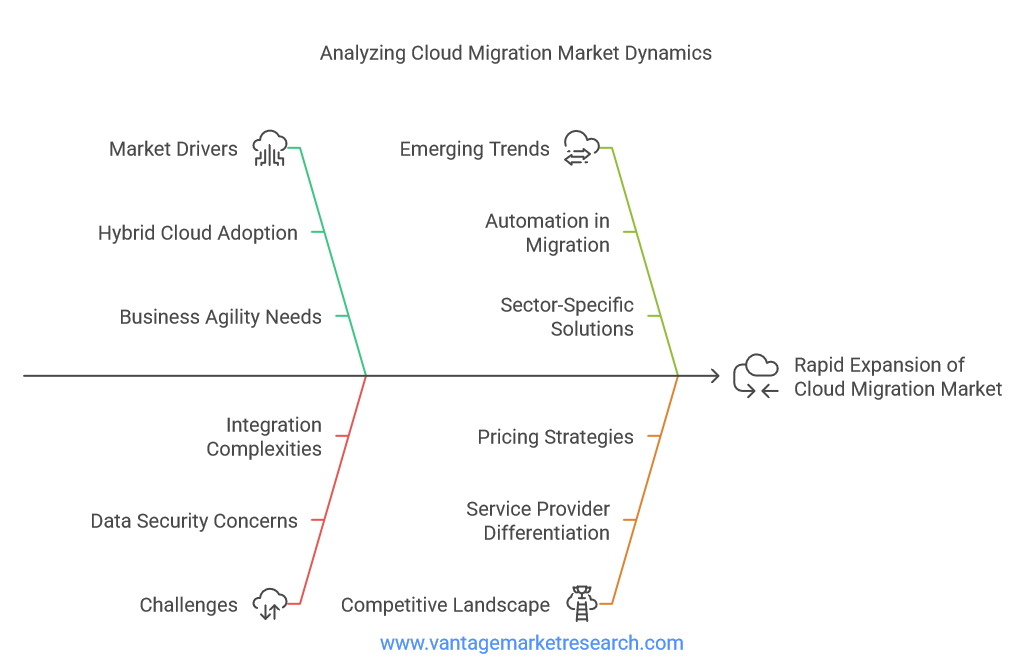The Impact of Business Agility on the Cloud Migration Services Market
Explore the current trends, challenges, and future outlook of the cloud migration services market, including the impact of automation and hybrid cloud solutions.

The Growth and Dynamics of the Cloud Migration Services Market
Vantage Market Research provides a comprehensive overview of the cloud migration services market, highlighting its current value, projected growth, key drivers, challenges, and emerging trends. With the increasing adoption of hybrid cloud solutions and the need for business agility, the market is poised for significant expansion. This article delves into various aspects of cloud migration, including the role of automation, sector-specific adoption trends, and the competitive landscape, offering insights into the future of this rapidly evolving industry.
Growth of Cloud Migration Services Market
The Global Cloud Migration Services Market is experiencing remarkable growth, with a valuation of USD 114.08 billion in 2022 and projections to reach USD 637.66 billion by 2030. This growth represents a compound annual growth rate (CAGR) of 24.00% over the forecast period. Several key factors are driving this demand, including the increasing adoption of hybrid cloud solutions, the necessity for business agility, and the rising implementation of automation solutions.
The shift towards hybrid cloud environments is a significant driver of market expansion. Organizations are increasingly recognizing the benefits of hybrid models, which offer enhanced flexibility, scalability, and operational efficiency. By optimizing workloads and improving data management, businesses can reduce costs while meeting their unique operational needs. This trend is expected to continue, fueling the demand for cloud migration services as companies seek to transition to these more adaptable infrastructures.
Another critical factor influencing market growth is the rising need for business agility. In a rapidly changing business landscape, companies across various sectors are prioritizing digital transformation initiatives to maintain a competitive edge. Cloud migration allows organizations to respond swiftly to market changes, enhance collaboration, and streamline operations, making it an essential component of modern business strategies. As businesses increasingly recognize the importance of agility, the demand for cloud migration services is expected to rise.
The implementation of automation solutions is also playing a crucial role in accelerating cloud migration. Businesses are integrating automation tools to simplify migration processes, reduce downtime, and minimize operational risks. Automation-driven cloud migration enhances efficiency, lowers costs, and improves security, making it a preferred choice for enterprises looking to modernize their IT infrastructure. For example, Amazon Web Services (AWS) recently launched AWS Migration Hub Automation, which streamlines cloud migrations by automating common tasks, thereby reducing manual effort and improving efficiency.
Additionally, the demand for faster and more straightforward application deployment is propelling market growth. The pay-as-you-go model offered by cloud service providers allows businesses to scale resources based on demand while minimizing upfront costs. This model supports cost-effective IT infrastructure management and facilitates seamless migration of applications, further driving the adoption of cloud migration services.

Role of Business Agility in Migration
Business agility has become a cornerstone of competitive advantage in today's fast-paced market environment. Organizations that can quickly adapt to changes in consumer preferences, market conditions, and technological advancements are more likely to succeed. Cloud migration plays a pivotal role in enhancing business agility by enabling companies to respond swiftly to evolving demands.
The speed and flexibility afforded by cloud migration allow businesses to implement changes rapidly, whether that involves launching new products, entering new markets, or adjusting operational strategies. By leveraging cloud-based solutions, organizations can enhance collaboration among teams, streamline processes, and improve overall efficiency. This agility is essential for maintaining a competitive edge in a landscape characterized by constant change.
Furthermore, the integration of cloud migration with broader business strategies is crucial for maximizing its benefits. Companies that align their cloud initiatives with their overall goals are better positioned to leverage the advantages of cloud technology. This alignment ensures that cloud migration is not merely a technical exercise but a strategic move that supports long-term business objectives.
Challenges in Legacy System Migration
While cloud migration offers numerous benefits, it is not without its challenges, particularly when it comes to migrating legacy systems. The complexity of migrating existing systems can pose significant hurdles for organizations. Legacy systems often involve intricate architectures, outdated technologies, and dependencies that can complicate the migration process.
One of the primary risks associated with legacy system migration is data loss and downtime. Organizations must ensure that critical data is preserved during the transition to the cloud, as any loss can have severe consequences for business operations. Additionally, downtime during migration can disrupt services and impact customer satisfaction, making it essential for businesses to carefully plan and execute their migration strategies.
Cloud migration services provide solutions to these challenges by offering expertise, tools, and methodologies designed to facilitate smooth transitions. By leveraging specialized migration services, organizations can mitigate risks, minimize downtime, and ensure a successful migration of their legacy systems to the cloud.
Sector-Specific Adoption Trends
The adoption of cloud migration services varies across different sectors, with certain industries experiencing more significant growth than others. For instance, the healthcare sector is increasingly leveraging cloud solutions to enhance patient care, streamline operations, and improve data management. The ability to securely store and access patient data in the cloud allows healthcare providers to deliver more efficient and effective services.
Similarly, the banking and financial services industry is undergoing a transformation as organizations transition to cloud-based solutions. The need for enhanced security, regulatory compliance, and operational efficiency is driving this shift. Cloud migration enables financial institutions to modernize their IT infrastructure, improve customer experiences, and respond more effectively to market demands.
The IT and telecommunications sectors are also witnessing substantial growth opportunities in cloud migration. As these industries continue to evolve, the demand for scalable and flexible cloud solutions is increasing. Companies in these sectors are adopting cloud migration services to enhance their service offerings, improve operational efficiency, and stay competitive in a rapidly changing landscape.
Impact of Automation on Cloud Migration
Automation is revolutionizing the cloud migration process, offering numerous benefits that enhance efficiency and reduce costs. By automating various aspects of migration, businesses can streamline their operations and minimize the manual effort required for successful transitions.
One of the primary advantages of automation in cloud migration is the reduction of manual efforts and errors. Automated tools can handle repetitive tasks, ensuring consistency and accuracy throughout the migration process. This not only speeds up the migration timeline but also reduces the risk of human error, which can lead to costly setbacks.
Moreover, automation enhances overall efficiency by enabling organizations to allocate resources more effectively. By automating routine tasks, IT teams can focus on higher-value activities, such as optimizing cloud environments and improving application performance. This shift in focus allows businesses to maximize the benefits of cloud migration while minimizing operational disruptions.
Emergence of Hybrid Cloud Solutions
The emergence of hybrid cloud solutions has transformed the landscape of cloud migration services. Organizations are increasingly favoring flexible cloud environments that combine the benefits of both public and private clouds. This preference is driven by the desire for enhanced scalability, security, and control over data.
Hybrid cloud models offer several advantages over traditional cloud solutions. They allow businesses to optimize workloads by placing sensitive data in private clouds while leveraging the scalability of public clouds for less critical applications. This flexibility enables organizations to tailor their cloud strategies to meet specific operational needs, driving increased adoption of hybrid cloud solutions.
Strategic collaborations among cloud service providers are also playing a crucial role in driving hybrid adoption. Partnerships that enhance service offerings and provide integrated solutions are helping organizations navigate the complexities of hybrid cloud environments. As businesses seek to leverage the advantages of hybrid models, the demand for cloud migration services that support these transitions is expected to grow.
Global Market Dynamics and Competition
The cloud migration services market is characterized by a dynamic competitive landscape, with several key players vying for market share. Major cloud service providers, such as Amazon Web Services, Microsoft Azure, and Google Cloud, are at the forefront of this industry, offering a range of migration services to meet the diverse needs of organizations.
Strategic partnerships and collaborations are enhancing service offerings and driving innovation in the cloud migration space. By joining forces, companies can leverage each other's strengths and provide comprehensive solutions that address the complexities of cloud migration. This collaborative approach is essential for staying competitive in a rapidly evolving market.
Regional differences in market growth and strategies also play a significant role in shaping the cloud migration services landscape. While North America remains a dominant player, emerging markets in Asia-Pacific and Latin America are witnessing increased adoption of cloud solutions. Understanding these regional dynamics is crucial for companies looking to expand their presence in the global cloud migration services market.
Future Trends in Cloud Migration Services
As the cloud migration services market continues to evolve, several trends are expected to shape its future. Innovations in technology, particularly the integration of artificial intelligence (AI) and machine learning tools, are driving the next phase of migration. These technologies can enhance decision-making processes, optimize resource allocation, and improve overall migration efficiency.
Predictions for the market landscape over the next decade indicate continued growth and diversification of cloud migration services. As organizations increasingly recognize the importance of cloud technology in achieving their business objectives, the demand for specialized migration services is expected to rise. Companies that can adapt to these trends and offer innovative solutions will be well-positioned to thrive in the competitive cloud migration services market.
FAQs
- What factors are driving the growth of the Global Cloud Migration Services Market?
- How is the adoption of hybrid cloud solutions impacting the market?
- What is the projected Compound Annual Growth Rate (CAGR) for the Cloud Migration Services Market from 2022 to 2030?
- What role does automation play in the expansion of cloud migration services?


















